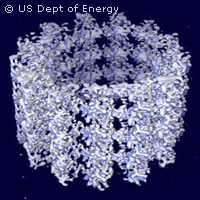Keeping traffic moving inside the cell
Researchers from the European Molecular Biology Laboratory (EMBL) have discovered new details of how molecules are transported around cells. Inside cells, molecules are transported to where they are needed along roads made up of filaments called microtubules. The system is a dynamic one, with microtubules assembling and growing where they are needed and shrinking when they are not. However, despite their temporary nature, while they are in use these roads need to be kept stable. How this stability is maintained was the focus of the EMBL's research. As well as transporting molecules, microtubules have a range of functions, including defining cell shape and segregating chromosomes during cell division. The basic building blocks of microtubules are proteins called tubulins. Tubulins form a single line to form protofilaments, which in turn come together to form a large tubulin sheet, which folds into microtubules. The researchers found that in yeast, a protein called Mal3p is vital to the last stage of the process; when the tubulin sheet folds into a tube, Mal3p molecules bind themselves at regular intervals along the resulting seam, thereby sealing the tube and strengthening what would otherwise be its weakest point. According to the researchers, without Mal3p the microtubules are unstable and prone to disassembling, while in its presence they grow into long filaments. The scientists believe that Mal3p could be a key regulator of microtubule behaviour, allowing for fast switches between growth and shrinkage of microtubules, something which is essential for fast and flexible transport of molecules in cells. 'It is the first time that we've found a protein that specifically binds to the microtubule seam,' said Andreas Hoenger, one of the authors of the paper. 'Until now the function of the seam has been unknown and it has been largely ignored as an odd and irrelevant part of the microtubule lattice. Our experiments now reveal it as a central spot where microtubule stability can be regulated.' However, as well as stabilising the cellular road system, the researchers think Mal3p could also act as an 'extra lane', providing an alternative path for molecules. 'Motor proteins move along microtubules through direct interaction with tubulin. They transport cargo similarly to trucks driving on motorways,' explained Damian Brunner, group leader at EMBL. 'The line of Mal3p along the seam potentially creates an alternative track on the filament, along which a specialised type of motor protein could move, just like creating a railway track along a motorway. This dual system could make transport more diverse and efficient.' The Mal3p protein is very similar across many species, and mutations in its human equivalent have been linked to neurodegenerative diseases.



